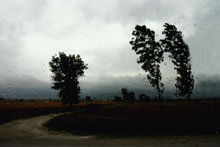Abbas Kiarostami
dal 7/7/2007 al 22/9/2007
Segnalato da
7/7/2007
Abbas Kiarostami
Berkeley Art Museum and Pacific Film Archive BAM/PFA, Berkeley
Image Maker

Image Maker
"One single picture could be the mother of cinema. That's where cinema starts, with one single picture."
"Contemplating the cloudy sky and the massive trunk of a tree under a magical light is difficult when one is alone. Not being able to feel the pleasure of seeing a magnificent landscape with someone else is a form of torture. That is why I started taking photographs. I wanted somehow to eternalize those moments of passion and pain."
Abbas Kiarostami
Abbas Kiarostami (b. 1940) is world renowned for his award-winning films, but he is also a poet, photographer, painter, illustrator, and graphic designer. To complement the film series being screened at PFA this summer, BAM is hosting an exhibition of Kiarostami's photographs. Kiarostami intensified his involvement with still photography at the time of the Iranian revolution, which was also a time of personal crisis for him. In each photograph, Kiarostami sets out to distill an image to its barest essence. He has said that he regards photography as a purer medium than film, since it is relieved of the burden of narrative or entertainment.
Kiarostami has already received acclaim for his two landscape series in black and white: Snow White and Roads and Trees (both 1978–2003). In the former, he explores the single motif of trees in snow, setting black silhouettes and gray shadows starkly against the blank white snow to yield images that are at once harsh and sublime. The series evolved out of Kiarostami's long, solitary walks in winter to search for film sets, sometimes covering thousands of miles in the Iranian landscape. Each image is suggestive of an emotional state, recalling the way clouds functioned for Alfred Steiglitz in his Equivalents series of the 1920s. In the documentary Roads of Kiarostami (2005), which combines moving and still images, Kiarostami notes that roads serve as a metaphor both in Persian poetry and in Japanese haiku, where they signify life itself.
In Roads and Trees, roads traverse barren, mostly unpeopled landscapes. Roads also figure prominently in Kiarostami's films, as both a formal and a metaphoric device. Another point of resemblance between Kiarostami's films and his photographs is the prominence of the automobile. In several films, the protagonist is behind the wheel of a car or filmed from above while driving on windy, dusty roads on the outskirts of town. The car is again the center of his new color series Rain (2006), shown for the first time this spring at P.S.1 in New York. Kiarostami focuses on partially obscured landscapes or city streets seen through the rain-streaked windshield of his car. In Trees and Crows (2006), a second color series that also premiered at P.S.1, crows walk amongst imposing, sometimes severely cropped tree trunks in the verdant palace grounds in Tehran. Crows, which have very long lives, have been silent witnesses to the turbulent history of modern Iran. Trees are a persistent theme in all of Kiarostami's work, be they stately and majestic or precarious survivors in an inhospitable environment. They symbolize for the artist endurance and adaptability.
Completing the exhibition is the film installation Summer Afternoon (2006), an interior scene that depicts shadows moving against a curtained window. A fan installed in the gallery behind the viewer gives the sensation that one is actually standing before the window.
BAM/PFA
2626 Bancroft Way - Berkeley



